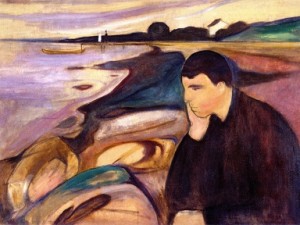By Cecilie Nyman
I will dig into the field of expressive art and Expressionism. Art has always been a symbolic and expressive way of communication. The artist is expressive. He tells stories of his time and people, he depicts landscapes – beautiful like a dream or wild and threatening, he paints the still life delicate or in decay. He paints layers and secrets. He plays with us, he challenges us. By the use of colors and by his way of leading the brush over the canvas, he reveals an deeper sphere. The artist impresses, expresses, pleases and disturbs.
Years ago, a voice inside me convinced me to grab the brush and paint – to express my inner landscape, influenced by the outer world – in order to gain insight?
I don’t know who I am today, until I paint. In the working process one reveals oneself. The strongest feelings, pain and darkness, but also gratefulness and glimpses of immense joy are my mainspring, my motor. Beauty in the ugly fascinates me. I admire the courage by the tormented Munch and the wild Expressionists, the courage to break the boundaries in art – using dramatic and disturbing colors and brutish brush strokes, experimenting and expressing to wake and to warn the world drowning in meaninglessness.
I’m exploring the expressive art, in order to understand my own longing to be expressive. The journey begins in Norway, I’ll go to France and to Germany, I will visit Egon Schiele – one of my favorite artists, but also the contemporary Expressionists; Per Kirkeby and Marlene Dumas. The list is long.
Expressionism – a new direction
“Man screams from the depth of his soul; the whole era becomes a single, piercing shriek. Art also screams, into the deep darkness, screams for help, screams for the spirit. This is Expressionism.” – Hermann Bahr (1863-1934), an Austrian Writer, playwright, director and critic.
An ism indicates a new direction. The Expressionism was a modernist movement that evolved in France and Germany in the beginning of 1900 and culminates during the Great War. The Expressionism encompasses art in which the artists are free to move beyond limitations, he is concentrating on the feelings affected by the pulse of his time. In Germany, especially two groups of artists experimented in the field of expressive art: Die Brücke and der Blaue Reiter. Their work signifies art of highly subjective and instinctive qualities. It was a reaction to the neat and superficial Realism and Impressionism.
Die Brücke wanted to scream out the madness and emptiness of the world, in the era of Industrialization. People are immigrating to the city, but are soon facing a life in smock, illness, poverty and loneliness, and the Great War is threatening. Die Brücke was greatly influenced by the symbolist painter and ‘Pre’-Expressionist from the cold and melancholic north, Edward Munch. His art was exhibited in Germany in 1892. It evoked bitter controversy (alias “The Munch Affair”), and after one week the exhibition closed. But the young artists in Germany felt immensely attracted to and inspired by his captivating, expressive art.
The journey has begun. Next time I will take you to Norway – to melancholy, anxiety and death.
‘From my rotting body, flowers shall grow and I am in them,
and that is eternity.’ – Edvard Munch
